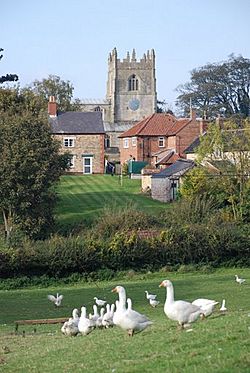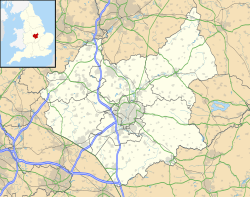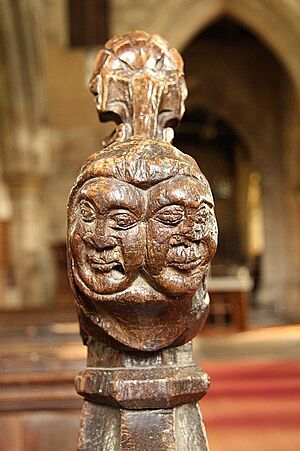Croxton Abbey facts for kids
 |
|
| Monastery information | |
|---|---|
| Order | Premonstratensian |
| Established | Land donated before 1159 Canons in residence from 1162 |
| Mother house | Newhouse Abbey |
| Dedicated to | St John the Evangelist |
| Diocese | Diocese of Lincoln |
| Controlled churches |
|
| People | |
| Founder(s) | William, Count of Boulogne and Mortain |
| Important associated figures |
|
| Site | |
| Location | Near Croxton Kerrial, Leicestershire, United Kingdom |
| Coordinates | 52°51′5.59″N 0°45′27.96″W / 52.8515528°N 0.7577667°W |
Croxton Abbey, located near Croxton Kerrial in Leicestershire, was a special kind of monastery. It belonged to the Premonstratensian order and was founded by William I, Count of Boulogne.
Contents
A Look Back at Croxton Abbey
Croxton Abbey was started by William, Count of Boulogne and Mortain. He gave the land for the abbey and also gave them control over some churches. This included the church in Croxton Kerrial and two churches in Derbyshire.
This gift of land happened before the Count died in 1159. However, the monks, called canons, didn't move in until 1162. Croxton Abbey was guided by its "mother house," Newhouse Abbey in Lincolnshire.
Over time, Croxton Abbey received more gifts. They gained control of other churches, like Sproxton and half of the church in South Croxton. They also got churches in Lancashire, such as Mellinge and Tunstall. In the early 1200s, a man named Philip D'Aubigny gave the abbey the manor of Waltham-on-the-Wolds.
For a short time, Croxton Abbey also oversaw other smaller monasteries. These included Blanchland Priory and Cockersand Priory. Cockersand was only under Croxton's control for about eight years. It then became an independent abbey in 1192. Blanchland also became independent later in the 1200s. Only Hornby Priory stayed connected to Croxton until the end of monasteries in England.
King John's Connection
In 1216, the leader of Croxton Abbey, known as the Abbot, was called to Newark Castle. This was because King John was dying there. The Abbot listened to the king's last confession. After King John died, the Abbot prepared his body for burial. King John's heart was buried right inside Croxton Abbey church. Later, King John's son, King Henry III, gave many gifts to the abbey to honor his father.
Challenges and Changes
The abbey faced tough times in the 1300s. In June 1326, a fire burned down the abbey church and other buildings. One monk even died in the fire. On top of that, Scottish raiders damaged the abbey's lands in northern England. By 1348, the abbey was in huge debt.
More bad luck came with the Black Death, a terrible disease. It killed almost all of the abbey's important monks, except for the Abbot and the Prior.
Despite these problems, the abbey also gained new things. Around 1335, they acquired the manor of Croxton Kerrial. In 1346, they gained control of the church in Finedon, Northamptonshire. Around 1362, Sir Andrew Louterel gave them the manors of Bescaby and Saltby.
Towards the end of its time, the abbey had a big argument with its patron, Lord Berkeley. He tried to stop the monks from choosing a new Abbot. He demanded a large payment from the monastery. Even though the monks refused to pay, the election was finally allowed. The new Abbot, who was the last one, still had to pay a large sum of money.
The End of the Abbey
Croxton Abbey was closed down in 1538. At that time, there were the Abbot and eighteen other monks living there.
Today, there isn't much left to see of the abbey. A private house on the site has parts of an old monastic building. This was probably the guest house, where important visitors stayed.
What the Abbey Looked Like
The abbey church had a simple cross shape. It was about 209 feet long. In the 1200s, a special area called a presbytery was added to the east end. This made the church a bit longer, about 209.5 feet.
The abbey also had a small cloister, which was an open courtyard. There was a chapterhouse, where monks met, a kitchen, and a refectory (dining hall). They also had a dormitory (sleeping area). A guest house was added in the 1300s for visitors.



